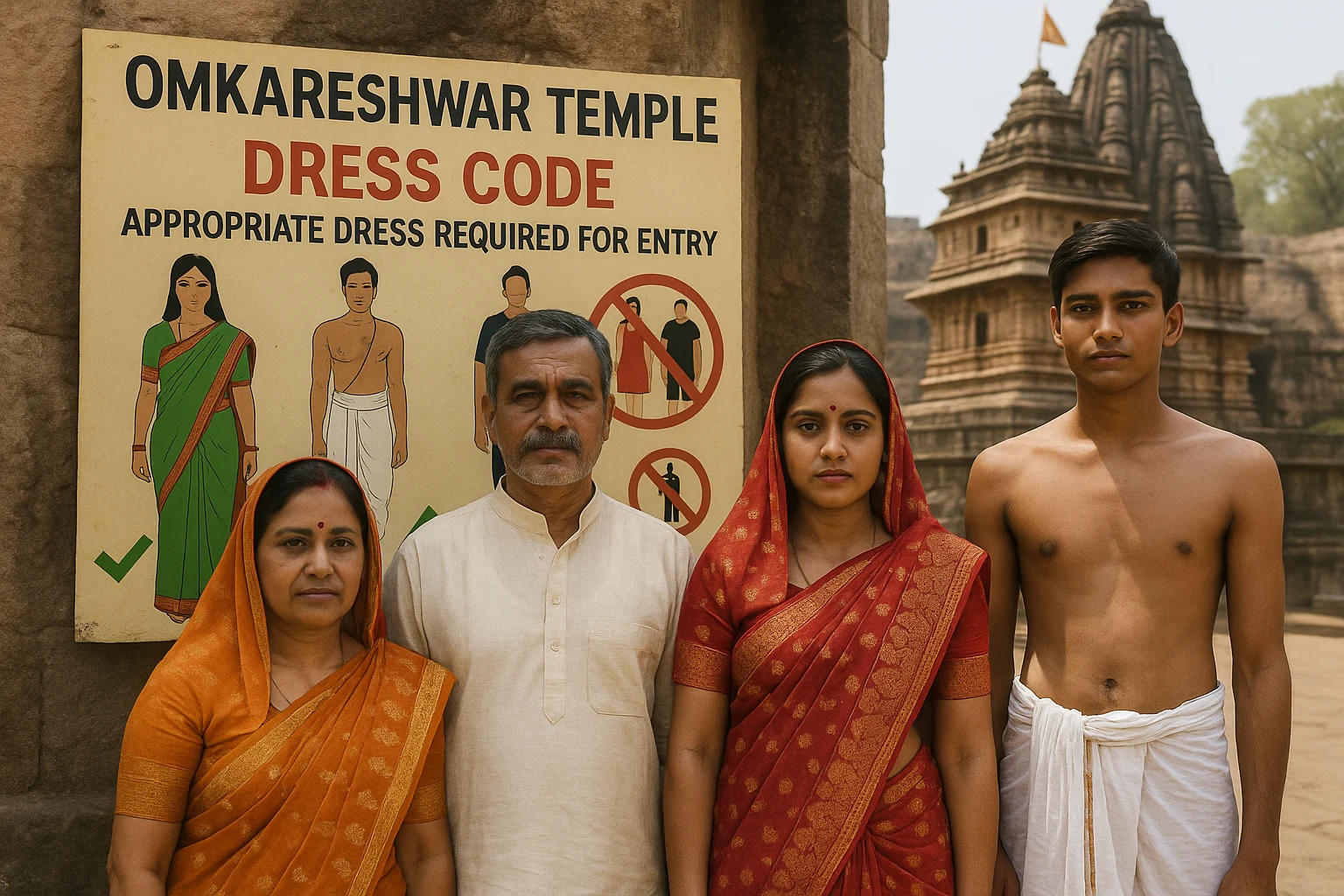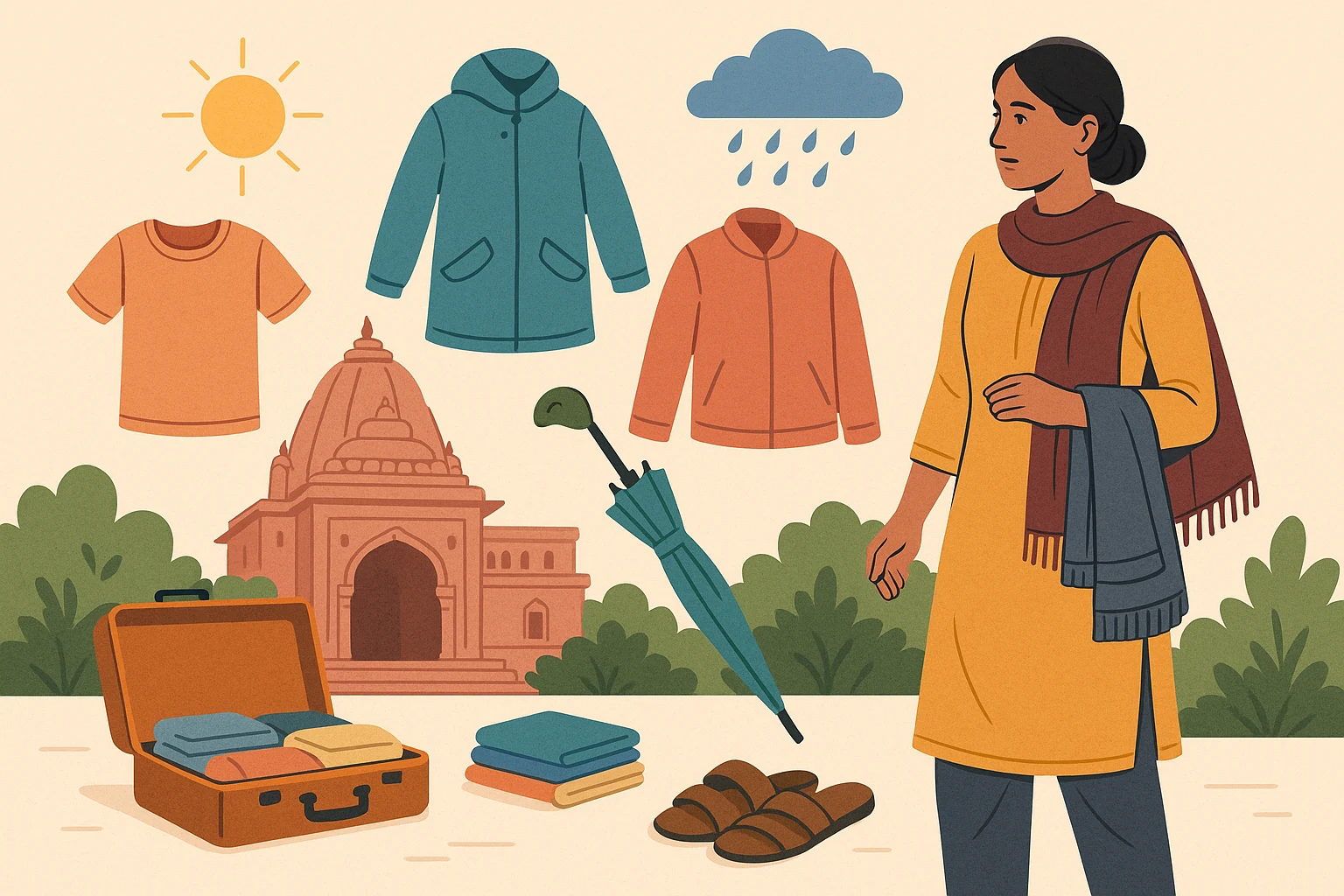Introduction
The sacred island in the Narmada River, shaped like the letter ‘ॐ,’ hosts Omkareshwar Temple—one of Lord Shiva’s twelve esteemed Jyotirlingas.
Thousands of devotees visit this ancient temple each year, seeking spiritual comfort, divine blessings, and the tranquil rhythm of life along the holy river. It is one of Madhya Pradesh’s most important pilgrimage sites.
The temple is a living example of India’s rich architectural and spiritual legacy and a representation of Shaiva devotion.
For everyone who visits, its timeless energy, customs, and scenic beauty provide a profoundly transforming experience.
It is more than just custom to dress modestly and respectfully when entering such hallowed places; it is a sign of respect.
Temples are places of faith and prayer, not tourist destinations, so attire should be modest and devoted to the place.
When visiting Omkareshwar Temple, it’s essential to understand the proper attire for your yatra. This guide will help you know what to wear, what to avoid, and offer tips to ensure a comfortable and spiritually respectful experience.
About Omkareshwar Temple
Omkareshwar Temple, one of Lord Shiva’s twelve sacred Jyotirlingas, is located on an island in the Narmada River in Madhya Pradesh. The island is spiritually significant due to its unique shape, which resembles the sacred Hindu symbol “ॐ.”
Legend says Lord Shiva appeared here to bless sages after their intense penance. Revered for centuries, the temple is mentioned in ancient texts and respected by pilgrims, saints, and kings alike.
Its Nagara-style architecture features a towering shikhara, carved stone pillars, and a peaceful sanctum radiating divine energy. The soothing flow of the Narmada River adds to the meditative atmosphere.
Every day, thousands of devotees climb the temple steps with prayers and offerings in hand.
To honor the sanctity of the space, visitors should follow basic cultural etiquette: remove shoes, speak softly, and dress modestly and respectfully on temple grounds.
Importance of Dressing Modestly in Hindu Temples
Going to a temple is a sacred act of humility, surrender, and inner purification in Sanatan Dharma (Hinduism), not merely a ritual.
Traditional and modest clothing is one way that this respect is shown.
Dressing appropriately is considered a sign of respect for the deity and the sanctity of the temple space, even though strict enforcement may not always be enforced.
The divine is actively worshipped at temples like Omkareshwar, which have great spiritual power as a Jyotirlinga.
Traditional belief holds that a devotee’s bhav (inner intention) is reflected in their clean, simple, and modest clothing, which also helps to maintain the space’s purity (shuddhi).
In addition to improving your spiritual state, dressing modestly—covering your shoulders and legs and avoiding gaudy or revealing clothing—makes you feel more connected, focused, and respectful during darshan or puja.
According to Hindu belief, one must approach the divine with a clean body, a clean mind, and clean clothing.
Observing this long-standing custom enhances your individual devotional experience while also respecting the temple’s hallowed ambience.
Recommended Dress Code for Omkareshwar Temple
When you visit a holy place like Omkareshwar Temple, your clothing should demonstrate your respect for the spiritual environment and your devotion.

Although there isn’t a strict dress code, the temple does encourage modest, traditional attire that respects the space’s holiness.
For Men:
- Wearing traditional Indian clothing, such as a kurta-pyjama or dhoti-kurta, is advised.
- Full-length pants and a basic shirt or t-shirt are also appropriate if that isn’t possible.
- Avoid shorts, sleeveless shirts, and excessively relaxed attire, particularly when attending rituals or entering the main temple.
For Women:
- Women are encouraged to wear modest Indian clothing, such as a saree, salwar kameez, kurti with leggings, or long skirts with a dupatta or shawl.
- Steer clear of tight-fitting or revealing clothing, such as sleeveless dresses, crop tops, and short dresses.
Seasonal Clothing Tips:
- Summer (March–June): Wear light, breathable cotton clothes to stay calm and comfortable.
- Winter (Nov–Feb): Carry a shawl, sweater, or layered clothing, especially for early morning darshan.
- Rainy Season: Quick-dry or spare clothes are helpful during monsoon months.
Footwear Etiquette:
- Before entering the inner sanctum or temple complex, shoes must be taken off.
- For convenience, there are designated lockers and shoe stands close to the entrance.
- Respectful attire not only upholds temple customs but also improves your spiritual experience when you receive Lord Omkareshwar’s darshan.
What Not to Wear at the Temple
Although anyone can visit Omkareshwar Temple, it is essential to remember that it is a hallowed place of worship rather than a tourist destination.
It is a sign of humility and respect for god and other devotees to dress appropriately.
Clothing that is deemed disrespectful in a traditional temple setting should be avoided by visitors.
This comprises:
- Shorts, miniskirts, crop tops, torn jeans, and sleeveless tops might be viewed as too casual or revealing.
- Body-hugging or tight-fitting apparel, which detracts from the spiritual atmosphere and attracts needless attention.
- Loud or ostentatious attire that detracts from the temple’s tranquil ambience, such as glittery gowns, sequined shirts, or vivid neon hues.
Furthermore, according to Hindu tradition, leather goods such as wallets, shoes, and belts are impure and should not be brought into the hallowed spaces.
- Before you enter the temple grounds, always take off your shoes.
- There are designated shoe stands close to the entrance.
- Your devotion should be reflected in the way you look.
- Dress simply, neatly, and respectfully so that you can fully participate in the experience of divine worship and integrate into the temple’s spiritual energy.
Special Dress Guidelines for Pujas and Abhisheks
Follow the traditional dress code for sacred ceremonies like Rudrabhishek, Jalabhishek, or other special pujas at Omkareshwar Temple. Men are usually required to wear a cotton dhoti and an angavastram, especially during Abhishek rituals.
In many temples, men must remove stitched upper garments like shirts or T-shirts before entering the inner sanctum. Women are advised to wear a saree or modest Indian attire such as a salwar kameez with a dupatta. Tradition emphasizes simplicity, modesty, and spiritual purity.
Wet clothes or Western outfits are not allowed inside the sanctum during rituals. Such clothing is frequently regarded as unsuitable for religious events.
It is best to inquire about any special dress codes or requirements with the priest or temple office before your visit, particularly during Mahashivratri or Shravan Maas or when making a reservation for a puja.
Following these rules guarantees that your ritual participation is deferential, spiritually rewarding, and consistent with long-standing temple customs.
Facilities & Services for Devotees
Omkareshwar Temple provides devotees with a number of valuable amenities to guarantee a hassle-free and comfortable stay.
Cloak rooms and special shoe stands are located at the temple entrance, where you can securely leave your shoes prior to darshan.
Large crowds are accommodated by the management and upkeep of these spaces, particularly during festivals.
Shops close to the temple complex offer reasonably priced dhotis, sarees, dupattas, and puja items for visitors who do not wear traditional clothing. These stores also provide quick buys for last-minute needs.
Several changing rooms and basic rest areas are available for visitors needing to freshen up after long journeys. Lockers are provided to safely store valuables like wallets, phones, or bags, as cell phones and leather items are not allowed in the sanctum.
With the support of these facilities, devotees can concentrate on their spiritual experience without concerns about possessions or attire.
Dressing for the Weather & Journey
It’s crucial to dress seasonally as well as modestly when organising your trip to Omkareshwar Temple.
Madhya Pradesh, where the temple is situated, experiences wildly fluctuating weather all year long.
Summer (March to June) can get very hot, so wear light, breathable cotton clothes to stay calm and comfortable. Winter (November to February) brings chilly mornings and evenings, so pack a light jacket or warm shawl.

During the monsoon season, sudden rain is common, so carry an umbrella or raincoat, quick-dry clothes, and an extra outfit. Wear sandals or comfortable shoes for walking, but remember to remove them before entering the temple complex.
During your spiritual yatra, a little preparation will guarantee that you are both comfortable and respectful.
Tips for Foreign Tourists & First-Time Visitors
If you are a foreign visitor or this is your first time at Omkareshwar Temple, it is strongly advised that you wear modest, Indian-style attire.
Observing local customs demonstrates spiritual respect and cultural sensitivity, even though the dress code may not be strictly enforced.
- It’s appropriate and comfortable to dress in long skirts, loose-fitting pants, kurtas, or tunics.
- It is beneficial for women to carry a dupatta or scarf, particularly if they want to cover their heads during puja or when entering the sanctum.
- If you don’t own traditional clothing, don’t worry; there are plenty of stores close to the temple that sell affordable kurtas, sarees, and dhotis, as well as rental options for special events.
- It is not appropriate to wear beachwear, shorts, tank tops, or gym attire on temple property.
Respecting the spiritual ambience improves the shared space for all devotees as well as your experience.
Conclusion
Omkareshwar Temple is not just a destination; it’s a spiritual journey that holds deep religious significance. Following a modest dress code shows respect, humility, and alignment with the temple’s sacred spiritual environment.
Wearing proper attire honors cultural values, deepens your connection with God, and helps maintain the temple’s purity. Dressing appropriately reflects your intention to combine spiritual devotion with respect for cultural traditions at this holy site.
Also Read: Dress Code for Ujjain Mahakal Temple: What You Must Wear?

